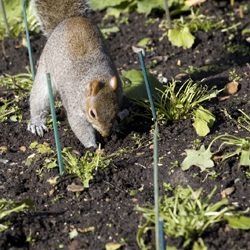This is the catalog time of year. Gardeners devour and drool over the spring-blooming bulb catalogs. We picture drifts of crocus and gaily swaying tulips…you know what I mean… ah, the garden will be great this next spring.
Until you remember last spring… Perhaps you planted dozens of promising bulbs and only a couple emerged. What happened?
Oh, yes…the squirrels. They also liked the bulbs, but unfortunately not for their beauty. From the looks of the remains, those bulbs became expensive squirrel food. If you want to plant daffodils, alliums, scilla, hyacinths, squills or fritillaria, your bulbs should be safe. Generally, squirrels don’t eat these.
Go ahead and order your bulbs. While you’re waiting for delivery, decide which of the three basic methods you will use to prevent the squirrel attacks. A small investment of time and materials will protect your bulbs.
1. Wire mesh is the best protection. Dig the hole for several bulbs, make a “cage” using mesh around the bulbs and fill in the soil. If the squirrels dig, the mesh will prevent them from eating the bulbs. You may also plant the bulbs as usual and place a layer of mesh on the soil. You’ll have to secure it to keep it in place then cover with mulch.
2. Repellants: Garden centers sell squirrel repellants. Deer repellants also repel squirrels. Some gardeners swear to the effective use of red pepper flakes mixed in the soil around, and over, the bulbs. Apparently, squirrels don’t like spicy!
3. Sharp gravel: Adding sharp gravel to the soil around and over the bulbs also deters squirrels from digging.
Of course, when planting, remove all bulb debris including the husks and tiny bulblets so the squirrels won’t know you’ve been there. There is another option. If you can’t beat ’em, join ’em…a squirrel feeding station may be just the thing to keep the squirrels from looking for your treasures!








